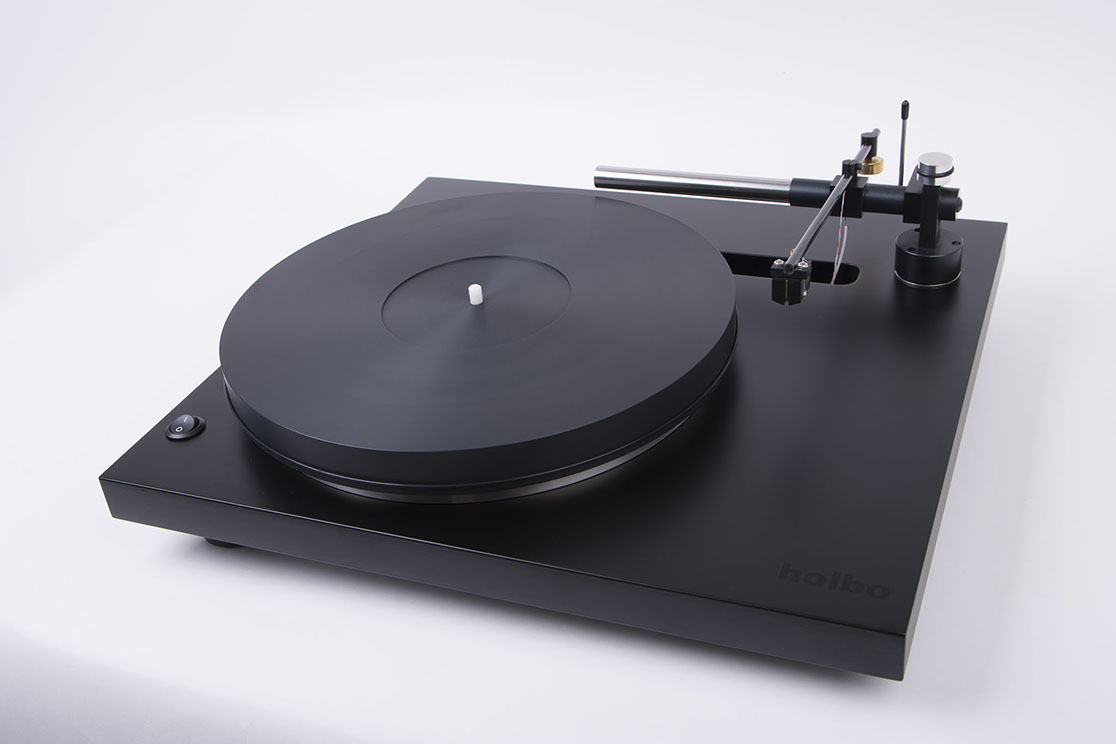The Holbo Turntable System is made in Slovenia by Bostjan Holc. The $7900 model has been available for a couple of years and consists of two very interrelated components: the airbearing turntable, where the platter rides on an airbearing; and the linear tracking tonearm, also incorporating an airbearing. There is no metal-to-metal contact anywhere in this novel and very effective design. For example, there is a huge non-magnetic stainless steel ring – mounted to the plinth – under the platter which concentrates resonance-dampening mass directly around the platter bearing where it is most effective.
The turntable is simple in design and easy to set up, with particular care required to make sure the turntable is level. The three vibration dampening feet are adjustable to assure a level platter and arm, and instructions are provided to assist the user in this critical task. Part of the setup is to set the VTF, or tracking force, to 0.1 grams to allow the cartridge to virtually float on the supplied protractor which confirms that the turntable is level. No bubble level or stylus force gauge is provided, so you will need to provide these necessary tools. The new owner should take their time in setup as the instructions are a little light (lacking) in detail.
The linear tracking tonearm is simple to set up, although different from the standard radial arms. With a linear tracking tonearm, you do not need to worry about which alignment to use, Baerwald, Loefgren, Stevenson, or any other. You simply mount the cartridge in the headshell and then the entire armwand can be moved forward or backward to assure perfect tangency across the entire surface of the LP. Tracking force, or VTF, is adjusted with a counterweight near the rear of the armwand. Connect the vacuum pump and the turntable power supply, adjust the internal electronic speed control for 33.3 RPM and 45 RPM using a strobe disk, and you are ready to play music. The vertical tracking angle, or VTA, is adjustable during play.
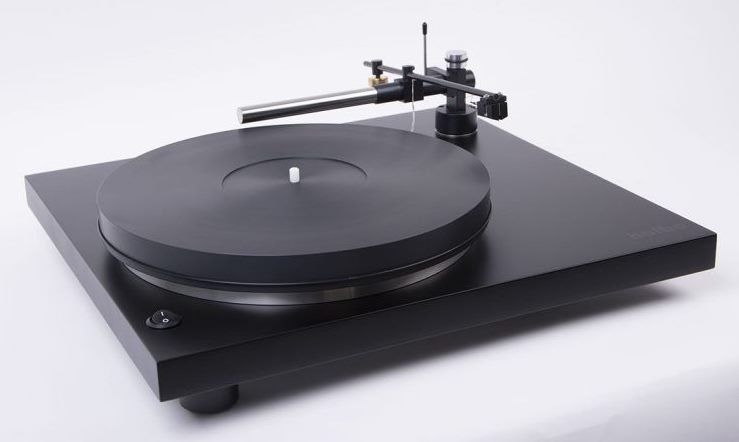
Other components on hand during the audition include a VPI Aries 3 turntable with a Kuzma 4-Point or Tri-Planar VII SE tonearm; ZYX UNIverse Optimum and Miyajima Madake moving coil cartridges; B.M.C. MCCI ULN and Aurorasound VIDA Prima phono preamplifiers; custom Windows 10 music computer running JRiver Media Center; Wyred 4 Sound DAC 2v2SE 10th Anniversary DA converter; RME ADI-2 Pro AD/DA converter with external power supply; Pass Labs XP-22, BAT VK-43SE, and Wyred 4 Sound STP-SE Stage 2 preamplifiers; Valvet E2 SE, Wyred 4 Sound ST-750LE, Cary SA-200.2 ES, and Benchmark AHB2 power amplifiers; Magico S1 mk.2 loudspeakers with the lowest few Hertz engaged by a pair of JL Audio e110 subwoofers, and Focal Chorus 714 loudspeakers borrowed from the HT system. The audio cabling is Audioquest WEL Signature, MIT MA-X SHD, Cardas Clear Beyond and Mogami interconnects and speaker cables. USB cables are Straight Wire USB-F. Power protection and purification are provided by an Audioquest Niagara 5000 or PS Audio Dectet for the preamplifiers and source components, and a PS Audio Quintet for the power amplifiers. The Quintet includes a standard 1/8″ trigger for remote turn-on and -off of power amplifiers that lack a 12V remote trigger. Power cords include my DIY power cord, Straight Wire Pro Thunder, and Audioquest Blizzard 20A (for the Niagara 5000). At the suggestion of the US distributor, Walker Audio Resonance Control Discs, $50 each, were used under the three turntable feet.
After lowering the stylus with the non-damped cueing lever, there seemed to be a silent explosion in my listening room as the walls and ceiling were demolished by the huge, 3-dimensional sound stage. Even compared to the other excellent arms on hand (pun intended), the Holbo Turntable System made the other arms sound almost defective. The loudspeakers disappeared into the sound field. The Magico speakers often do an excellent job of delivering a large virtual performance stage to the listening room, but the Holbo Turntable System obviously improved this performance to an immediately noticeable degree. The sound field is wide, usually extending outside the lateral limits of the speakers. Depth is remarkably accurate and precise, with stage depth about the same as the other fine tonearms. The center image is perfect: precise and focused.
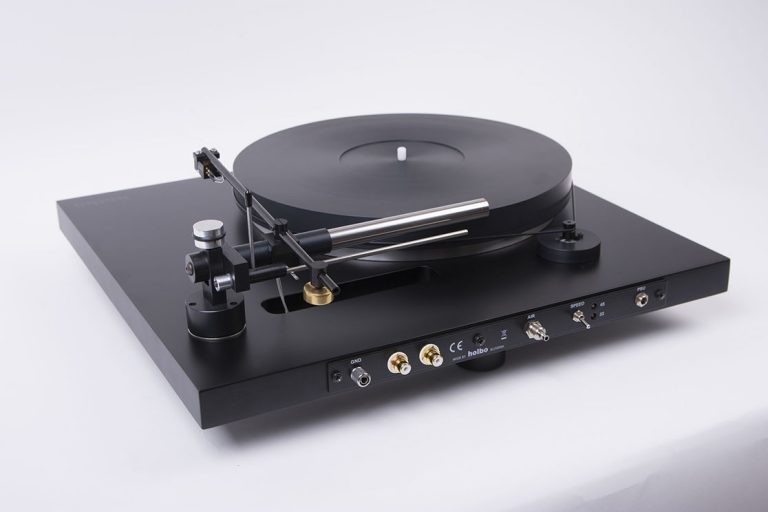
The Miyajima Madake moving coil cartridge loves this turntable. For that matter, so does the $17k ZYX UNIverse Optimum. The Madake sounded very delicate and nuanced, rich in harmonics. Separation of voices and musicians is truly outstanding. It never sounded better.
The bass goes very deeply into the lowest notes that the JL Audio subwoofers are able to reproduce. These subs are rated for -3 dB at 23 Hz and -10 dB at 18 Hz, and the Holbo turntable shows what these subs can really do. The bass is especially tuneful and very high resolution without being dry or threadbare. This continues into the mid-bass, making every bass line easy to follow. When the turntable was new, there was a slight coarseness in the upper bass and midrange, which was attributed to about 12 inches of new wiring. This disappeared after about 50 hours of record playing and never returned. The tonearm wiring is amazingly flexible, as is the very small diameter air hose for the airbearing arm.
Here is how the arm floats on air. The arm tube is attached to a round tube or collar, about 3 inches long. Air is pumped into this collar which lets it ride on a cushion of air as it glides across a highly polished, very precisely machined solid metal rod. The air is coming from the arm, not from tiny little holes in the supporting tube as you might see in other linear tracking tonearms. The tube is just a guide. The lateral resistance to moving the arm is extremely low. With the arm balanced so the cartridge just floats, a very small puff of air from your mouth moves the arm quite a distance. This demonstrates the very low resistance to movement.
The dynamic performance of this turntable system is totally satisfying. Small or micro dynamics have a scale or gradations that let one hear barely audible inflections and nuance in any recording. The tiny tap on a drum, or triangle, or pluck of guitar string, all have great clarity and presence. This character helps each performer stand out in the mix while precisely locating them on the performance stage. Notes are very precise and seemingly free of any blurring or loss of focus. This purity and freedom from distortions is really captivating. The listener receives a huge quantity of enjoyable music. Notes have an inner beauty and depth with tremendous harmonic richness.
Large scale or so-called macro dynamics are also outstanding, imbuing the music with power and momentum. There is no blurring or congestion of complex music. If the recording provides it, the Holbo Turntable System delivers both power and clarity. Excellent!
I expected some platter wobble from the airbearing platter. However, probably due to the very fine machining of the parts of the bearing, it took a lot of force to rock the platter from its normal position. This is interesting: It was almost impossible to visually confirm that the 11 pound platter was turning. The machining of the platter is so exquisitely precise that even a light shining directly on the brand new spinning platter did not reveal any inconsistencies or defects in the perfectly flat platter surface. This is probably at or very close to the level of precision possible with current technology. Amazing!
When the power switch is turned off, the platter continues to spin for about 1 1/3 revolutions. The platter will continue to float on its cushion of air when the power switch is off, as long as the external air pump, which is connected to the turntable with a long length of air tubing, is left running. The puffing of air as it enters the pump is louder than the pump itself, although remote placement of the pump is highly recommended as it is not quite silent in operation.
Compared to the VPI Aries 3 turntable with Triplanar VII SE tonearm, the Holbo delivers a larger and more precise soundstage with a better appreciation for the size of the recording venue. The Aries 3, with its 20 pound platter and periphery ring clamp offers a small degree of extra weight in the 80-200 Hz range (upper bass, lower midrange). A small difference, yes, but not enough to urge a preference in this area for one turntable over the other.
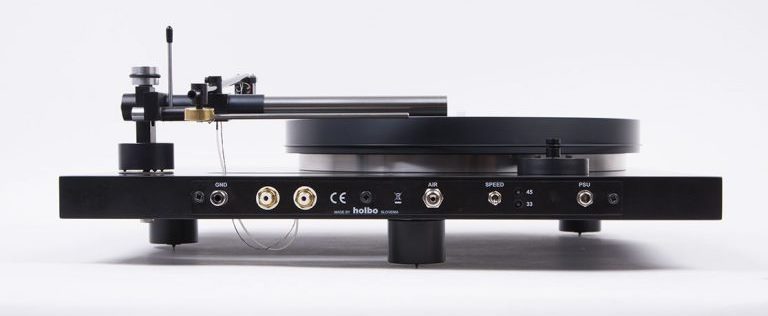
The real strength of the Holbo Turntable System is the compelling feeling of continuity and flow in the very linear and complete harmonic content of every voice and musical note. It just sounds whole with extremely high resolution right down to silence, and leading-edge clarity that defines each note as a distinct entity. There is no bass, midrange, treble in the usual, analytical sense. The entire musical spectrum is one continuous, highly transparent river of performance, drawing the listener in.
The bottom line for this reviewer is the answer to the dilemma of whether or not to return it to the distributor after the audition. I really struggled with this, as the performance of the Holbo Turntable System is superb, easily meeting the requirements of the Zen Page. Ultimately, the ability to change tonearms for reviews, as had been done with the three arms used on the Aries 3D, outweighed the more satisfying performance of the Holbo. The wonderful musicality of the Holbo Turntable System is missed every day.
Overall Rating: 10 LPs
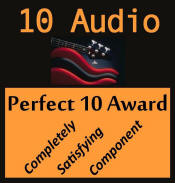
Link to distributor: highend-electronics
This review would not have been possible without the very kind support of Alfred Kainz, the US importer. Thank you, Alfred!

